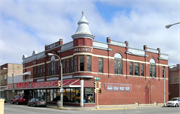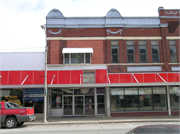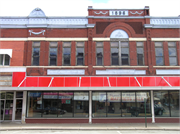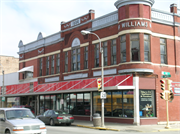Property Record
125 S WATER ST
Architecture and History Inventory
| Historic Name: | Williams Block |
|---|---|
| Other Name: | Mike's T.V. and Appliance |
| Contributing: | Yes |
| Reference Number: | 28034 |
| Location (Address): | 125 S WATER ST |
|---|---|
| County: | Monroe |
| City: | Sparta |
| Township/Village: | |
| Unincorporated Community: | |
| Town: | |
| Range: | |
| Direction: | |
| Section: | |
| Quarter Section: | |
| Quarter/Quarter Section: |
| Year Built: | 1896 |
|---|---|
| Additions: | 1972 |
| Survey Date: | 1989 |
| Historic Use: | retail building |
| Architectural Style: | Romanesque Revival |
| Structural System: | |
| Wall Material: | Brick |
| Architect: | Schick and Stoltze |
| Other Buildings On Site: | |
| Demolished?: | No |
| Demolished Date: |
| National/State Register Listing Name: | Water Street Commercial Historic District |
|---|---|
| National Register Listing Date: | 11/12/1992 |
| State Register Listing Date: | 7/3/1992 |
| National Register Multiple Property Name: |
| Additional Information: | A 'site file' exists for this property. It contains additional information such as correspondence, newspaper clippings, or historical information. It is a public record and may be viewed in person at the Wisconsin Historical Society, Division of Historic Preservation-Public History. In 1896, W.G. Williams built the present landmark building. From the corner heading north, in 1900, the original three business occupants were: Roberts and Jones grocery store, the E.L. Jones tailor shop, and Leader's Department stpre, Sparta's second real department store. On the second floor of the building, Sparta's City Council met in a hall. They were here from 1896 approximately 1911. The Roberts and Jones grocery store was the only one of three business occupants to stay business at this location. The Robert and Jones Grocery store was an important grocery in Sparta. The Robert and Jones grocery existed as early as 1888 and was operated by Stephen J. Roberts and William R. Jones at an unknown location. In 1896, the Robert and Jones grocery became an original occupant of the Williams Block, having a full line of staple and fancy groceries, as well as boots, shoes, etc. It occupied the Williams Block as late as 1935 or even longer. From the heading north, from 1904 to 1916, the E.L. Jones tailor was located in the building. In addition from 1906 to circa 1925 the Taylor Drug Company was located here. The Taylor Drug Company was established by Robert J. Taylor. The Taylor Drug Company began circa 1906 and occupied one floor and the basement of the Williams Building. The Taylor Drug Company carried not only all lines of drugs, but also wallpaper, cut glass, mixed paints, and sundries, including "stationery, school supplies, perfumes, toilet articles, souvenir post cards, cigars and confectionary in the leading brands, especially Lowney's chocolates of Boston, Mass." Sometime around 1925, the Taylor Drug Company moved to a different location. The Williams Block Building gains local historical significance under Criteria in association with several topics in Sparta's Commerce, Governement and Industry Themes. It was the home of the Roberts and Jones grocery and the Leader Department Store, both prominent businesses in Sparta's past. In addition, the second floor of the building was used by the City Council for several years. Lastly, from 1906 to circa 1925, the Robert J. Taylor Drug Company, an important drugstore in Sparta's past, was located here. The building's period of historical significance ranges from its erection in 1896 to circa 1935 when the last well-documented business was located here. Constructed on the corner of Water and Oak Streets in the Victorian Romanesque Revival style, this two-story red brick commercial block's most visul characteristic is a corner tower or turret covered by a staged conical tower with overhanging moulding around its base. The turret is further characterized by rectangular windows on the second story and small attic windows on the third story. The name of the owner "Williams" is applied to the spandrel between the windows that is outlined by white stone belt courses along the lintel and sill courses. The main facade on Water Street, divided vertically into three large bays, is characterized by an ornamented center bay that features a classical entablature resting on slender capped pilasters. The center bay is accented by a rectangular peidment rising above the roof line that is flanked by brick piers, inscribed "1896" and decorated with appliqued classical swags. A Palladian styled window on the second story enframed by the applied pilasters of the center bay displays a round arched window with a tympanum decorated by an appliqued floral design and by contrasting white stone imposts, which extend across the top of the two flanking rectangular windows. The south facade on Oak Street is also characterized by two similar bays but with simple arched windows are located alternately with less ornamental bays characterized by plain rectangular windows. An arcaded metal cornice, broken by the pedimented bays rising above the roof line and continuous with the identical cornice on the Hoffman building at 123 South Water (MO37/4), ornaments the top of the Water and Oak Street facades. The facades are further divide horizontally by white stone belt courses running along the lintel and the sill courses. A single round arched entrance door is located at the east end of the south elevation on Oak Street. A contemporary style storefront with a cantilevered canopy and recessed entrance on the north end presently is located on the Water Street facade. Although the architectural details associated with the Romanesque Revival style have been preserved, this building was seriously altered in 1972 by the Schultz Clothing Co. when the window sashes and lights on the upper story as well as the turret and the arched door on the south facade were closed with stuccoed panels. The original iron storefrton, which extended around to one bay of the Oak Street facade, has been replaced, presently partially filled with bricks and partially with metal and glass. The stairway to the upper story was removed to allow for more store space on the lower story. This prominent commercial block was constructed in 1896 by local contractors Louis Huschka and H. Davenport. Designed by La Crosse architects Schick and Stoltze, this building, built as investment property for W.G. Williams and G. Simpson was the sole property of Williams by the time the project was completed. This building, designed to accomodate three 20 ft. stores, one small four ft. store space, and a 5 ft. stairway, was constructed at the same time as the adjacent Hoffmamn building, using similar construction materials such as concrete for the foundation and steel beams made at the Sparta Iron Works. Originally, this building housed the Robert and Jones Grocery Store in the south store [129 South Water], the E.L. Jones Tailor Shop in the center store [127 South Water], the Leader Dry Goods Store in the north store [125 South Water], Drs. Beebe, Saules, Beebe on second, and the City Council Hall on second. Presently, the building accomodates one large commercial space. The Williams Block does not meet the criteria of the NRHP for architectural significance because of a lack of integrity. Important as a substantial examples the Romanesque Revival, the architectural merit of this historically significant commercial block was diminished when the windows were removed in 1972. However, this building has sufficient architectural character to contribute to proposed Water Street Historic District. |
|---|---|
| Bibliographic References: | (A) City of Sparta, WI, Community Development Office, Building Permit File. (B) City of Sparta Tax Records, 1870-1930. (C) Sparta Herald Sept. 8, 1891; June 9, 1896; July 7, 1896; July 21, 1896; Sept. 29, 1896. (D) Sanborn Insurance Maps 1889, 1894, 1900, 1911, 1922, 1931. (E) City of Sparta Property Tax Rolls, 1870-1940. (F) Annual Directory of Sparta, Wisconsin. Vol. 1. Chicago: Interstate Directory Co., 1897. (G) Sparta City Directory, 1903-1904. Sparta: R.C. Glover, 1904. (H) City Directory of the City of Sparta, Wisconsin. Sparta: compiled and published by E.B. Bell, 1916. (I) "Roberts and Jones," Monroe County Historical Society. Vol. IV, No. 9 (February 1985):4. (J) Monroe County Democrat "Sparta-Up-To-Date," June 30, 1899:23. (K) WIsonsin Gazetter 1888-1889; 1927-1928. (L) Barney, Tyler Davis, "A History of the Growth of Sparta, Wisconsin, 1850 to 1890." B.A. Thesis. University of Wisconsin, 1922, p. 41. (M) "Taylor Drug Company," Monroe County Historical Society, Vol. 2, No. 8 (June 1978):2. |
| Wisconsin Architecture and History Inventory, State Historic Preservation Office, Wisconsin Historical Society, Madison, Wisconsin |





